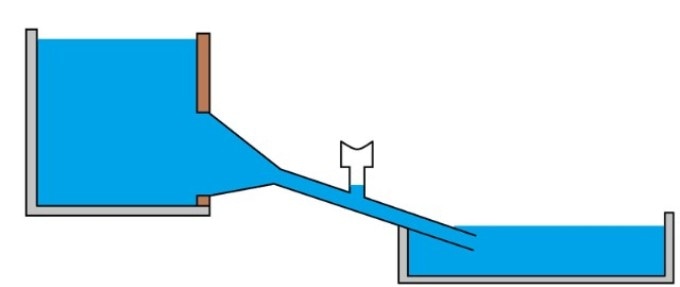Oct 3 2017
The Bavarian Energy Map indicates that to date, water is the primary renewable energy source in Bavaria, Germany. Nearly 33% of the entire renewable energy is produced in Bavaria.
However, traditional hydroelectric plants, specifically the micro-hydro generators, are unpopular owing to their negative impact on the ecosystem and their lower energy output. Scientists at the Fraunhofer Institute for Silicate Research are striving to develop an eco-friendly substitute—going forward, unconventional elastomer materials may be used to directly transform the mechanical energy of water flowing in small rivers into electrical energy.
 Cross section of the Venturi tube. When the water flows through the uptake tube, negative pressure builds that forces the elastomer film (center of the image) to extend inwards. CREDIT: Fraunhofer ISC.
Cross section of the Venturi tube. When the water flows through the uptake tube, negative pressure builds that forces the elastomer film (center of the image) to extend inwards. CREDIT: Fraunhofer ISC.
The Bavarian State Government, as part of its energy policy, has stipulated new goals for adapting a greener energy economy—by the year 2025, nearly 40% of electricity needs in Bavaria might be met by local renewable energy sources. As part of the DEGREEN project, the Fraunhofer Institute for Silicate Research ISC has undertaken a novel proposal to produce renewable energy by means of hydropower. Hence, the Würzburg-based Scientists have adopted ultra-thin and extremely flexible elastomer films functioning as capacitors.
A conductive elastic layer is coated on either side of the silicone films, and a protective insulation layer is coated above the elastic layer. When the films are positioned in small streams and rivers, the mechanical kinetic energy of water is directly transformed into electrical energy due to the continuous deformation and relaxation of the elastomers. The soft film is deformed by the flowing water, where the features of the film are same as those of a balloon. When the films are deformed, they carry higher electric charge produced during the stretching process. Then, the elastomer film gets mechanically relaxed to its actual state.
At this point, a high volume of electrical energy has been generated and charges a temporary storage device on an integrated circuit. It is from here that we siphon the energy. This deformation and relaxation cycle is repeated once a second. If we apply a potential of 4000 volts, for each deformation we can generate 100 milliwatts of electrical power per film.
Dr Bernhard Brunner, Project Manager and Scientist, Fraunhofer ISC
However, the question remains, “How can we bring about this cyclic deformation in the films?” Brunner and his colleagues have executed an intelligent mechanical excitation process. Flow of water inside a narrow tube gives rise to negative air pressure (namely the Venturi effect) that culminates in the deformation of the elastomer film. Next, an air valve is opened to balance the negative air pressure, making the elastomer film to go back to the non-deformed state. The most creative part of the design is that the air vent self-controls itself, that is, it can open and close itself without the need for power or electronics.
Ideal location: Streams and small rivers
The Scientists can adjust the pressure by changing the film’s diameter. As a result, the generator can be adjusted according to the flow rate. The system as a whole has a modular structure due to the presence of the tube, air duct, films, pump, electronics, vent and rectifier. With an adjustable diameter, the tubes can be adjusted corresponding to the width and depth of water and can be fixed on top, at the back, or next to each other. If a river is wide but shallow, it is recommended to mount the tubes next to each other.
“One major advantage of our concept is its flexibility: it can be used in water of any depth. We harness the water’s fluid energy. Our elastomer generators are ideal for small rivers and can be operated at flow velocities from as low as 0.5 meters per second and at depths of 0.5 meters. In Bavaria, there are some exceptionally small rivers which together cover a length of some 30,000 kilometers. Our system, which is not influenced by wind or sun, is the perfect solution. If we installed 1000 of our generators, we could help bring Bavaria a major step closer to achieving its transition towards greener energy,” stated Brunner.
This system has the ability to supply the grid with a total power of 876 MWh per annum. Apart from Switzerland and Austria, countries with bountiful mountainous streams, the novel mechanical excitation concept will also prove advantageous to developing countries.
Decentralized energy supply
The elastomer generators have been developed such that they function quietly in small and shallow waters with no check dams. For instance, they are highly appropriate to be used as a decentralized power supply for remote settlements or campsites very near to water resources.
At present, Brunner and his colleagues are designing two kinds of generator in the laboratory—one floats on the water and one is secured to the riverbank. They have also proposed to miniaturize the size of the generator. They anticipate that when the project comes to an end, they will have developed a flood- and weather-proof system whose size is equal to that of a switch control box.
Besides the investigations carried out in the lab, the Fraunhofer Researchers have closely collaborated with the water board, local authorities and environmental authorities to perform field investigations of prototypes in the Wern and Tauber rivers, which produce real-life experimental conditions. The Researchers aim to constantly produce an electrical power of 100 Watts from one generator.